12.22: The Early Classical Period
- Last updated
- Save as PDF
- Page ID
- 263988
\( \newcommand{\vecs}[1]{\overset { \scriptstyle \rightharpoonup} {\mathbf{#1}} } \)
\( \newcommand{\vecd}[1]{\overset{-\!-\!\rightharpoonup}{\vphantom{a}\smash {#1}}} \)
\( \newcommand{\dsum}{\displaystyle\sum\limits} \)
\( \newcommand{\dint}{\displaystyle\int\limits} \)
\( \newcommand{\dlim}{\displaystyle\lim\limits} \)
\( \newcommand{\id}{\mathrm{id}}\) \( \newcommand{\Span}{\mathrm{span}}\)
( \newcommand{\kernel}{\mathrm{null}\,}\) \( \newcommand{\range}{\mathrm{range}\,}\)
\( \newcommand{\RealPart}{\mathrm{Re}}\) \( \newcommand{\ImaginaryPart}{\mathrm{Im}}\)
\( \newcommand{\Argument}{\mathrm{Arg}}\) \( \newcommand{\norm}[1]{\| #1 \|}\)
\( \newcommand{\inner}[2]{\langle #1, #2 \rangle}\)
\( \newcommand{\Span}{\mathrm{span}}\)
\( \newcommand{\id}{\mathrm{id}}\)
\( \newcommand{\Span}{\mathrm{span}}\)
\( \newcommand{\kernel}{\mathrm{null}\,}\)
\( \newcommand{\range}{\mathrm{range}\,}\)
\( \newcommand{\RealPart}{\mathrm{Re}}\)
\( \newcommand{\ImaginaryPart}{\mathrm{Im}}\)
\( \newcommand{\Argument}{\mathrm{Arg}}\)
\( \newcommand{\norm}[1]{\| #1 \|}\)
\( \newcommand{\inner}[2]{\langle #1, #2 \rangle}\)
\( \newcommand{\Span}{\mathrm{span}}\) \( \newcommand{\AA}{\unicode[.8,0]{x212B}}\)
\( \newcommand{\vectorA}[1]{\vec{#1}} % arrow\)
\( \newcommand{\vectorAt}[1]{\vec{\text{#1}}} % arrow\)
\( \newcommand{\vectorB}[1]{\overset { \scriptstyle \rightharpoonup} {\mathbf{#1}} } \)
\( \newcommand{\vectorC}[1]{\textbf{#1}} \)
\( \newcommand{\vectorD}[1]{\overrightarrow{#1}} \)
\( \newcommand{\vectorDt}[1]{\overrightarrow{\text{#1}}} \)
\( \newcommand{\vectE}[1]{\overset{-\!-\!\rightharpoonup}{\vphantom{a}\smash{\mathbf {#1}}}} \)
\( \newcommand{\vecs}[1]{\overset { \scriptstyle \rightharpoonup} {\mathbf{#1}} } \)
\( \newcommand{\vecd}[1]{\overset{-\!-\!\rightharpoonup}{\vphantom{a}\smash {#1}}} \)
\(\newcommand{\avec}{\mathbf a}\) \(\newcommand{\bvec}{\mathbf b}\) \(\newcommand{\cvec}{\mathbf c}\) \(\newcommand{\dvec}{\mathbf d}\) \(\newcommand{\dtil}{\widetilde{\mathbf d}}\) \(\newcommand{\evec}{\mathbf e}\) \(\newcommand{\fvec}{\mathbf f}\) \(\newcommand{\nvec}{\mathbf n}\) \(\newcommand{\pvec}{\mathbf p}\) \(\newcommand{\qvec}{\mathbf q}\) \(\newcommand{\svec}{\mathbf s}\) \(\newcommand{\tvec}{\mathbf t}\) \(\newcommand{\uvec}{\mathbf u}\) \(\newcommand{\vvec}{\mathbf v}\) \(\newcommand{\wvec}{\mathbf w}\) \(\newcommand{\xvec}{\mathbf x}\) \(\newcommand{\yvec}{\mathbf y}\) \(\newcommand{\zvec}{\mathbf z}\) \(\newcommand{\rvec}{\mathbf r}\) \(\newcommand{\mvec}{\mathbf m}\) \(\newcommand{\zerovec}{\mathbf 0}\) \(\newcommand{\onevec}{\mathbf 1}\) \(\newcommand{\real}{\mathbb R}\) \(\newcommand{\twovec}[2]{\left[\begin{array}{r}#1 \\ #2 \end{array}\right]}\) \(\newcommand{\ctwovec}[2]{\left[\begin{array}{c}#1 \\ #2 \end{array}\right]}\) \(\newcommand{\threevec}[3]{\left[\begin{array}{r}#1 \\ #2 \\ #3 \end{array}\right]}\) \(\newcommand{\cthreevec}[3]{\left[\begin{array}{c}#1 \\ #2 \\ #3 \end{array}\right]}\) \(\newcommand{\fourvec}[4]{\left[\begin{array}{r}#1 \\ #2 \\ #3 \\ #4 \end{array}\right]}\) \(\newcommand{\cfourvec}[4]{\left[\begin{array}{c}#1 \\ #2 \\ #3 \\ #4 \end{array}\right]}\) \(\newcommand{\fivevec}[5]{\left[\begin{array}{r}#1 \\ #2 \\ #3 \\ #4 \\ #5 \\ \end{array}\right]}\) \(\newcommand{\cfivevec}[5]{\left[\begin{array}{c}#1 \\ #2 \\ #3 \\ #4 \\ #5 \\ \end{array}\right]}\) \(\newcommand{\mattwo}[4]{\left[\begin{array}{rr}#1 \amp #2 \\ #3 \amp #4 \\ \end{array}\right]}\) \(\newcommand{\laspan}[1]{\text{Span}\{#1\}}\) \(\newcommand{\bcal}{\cal B}\) \(\newcommand{\ccal}{\cal C}\) \(\newcommand{\scal}{\cal S}\) \(\newcommand{\wcal}{\cal W}\) \(\newcommand{\ecal}{\cal E}\) \(\newcommand{\coords}[2]{\left\{#1\right\}_{#2}}\) \(\newcommand{\gray}[1]{\color{gray}{#1}}\) \(\newcommand{\lgray}[1]{\color{lightgray}{#1}}\) \(\newcommand{\rank}{\operatorname{rank}}\) \(\newcommand{\row}{\text{Row}}\) \(\newcommand{\col}{\text{Col}}\) \(\renewcommand{\row}{\text{Row}}\) \(\newcommand{\nul}{\text{Nul}}\) \(\newcommand{\var}{\text{Var}}\) \(\newcommand{\corr}{\text{corr}}\) \(\newcommand{\len}[1]{\left|#1\right|}\) \(\newcommand{\bbar}{\overline{\bvec}}\) \(\newcommand{\bhat}{\widehat{\bvec}}\) \(\newcommand{\bperp}{\bvec^\perp}\) \(\newcommand{\xhat}{\widehat{\xvec}}\) \(\newcommand{\vhat}{\widehat{\vvec}}\) \(\newcommand{\uhat}{\widehat{\uvec}}\) \(\newcommand{\what}{\widehat{\wvec}}\) \(\newcommand{\Sighat}{\widehat{\Sigma}}\) \(\newcommand{\lt}{<}\) \(\newcommand{\gt}{>}\) \(\newcommand{\amp}{&}\) \(\definecolor{fillinmathshade}{gray}{0.9}\)Marble Sculpture and Architecture in the Greek Early Classical Period
Early Classical Greek marble sculptures and temple decorations display new conventions to depict the body and severe style facial expressions.
Learning Objectives
Describe the characteristics of the Kritios Boy, Spear Bearer, and the Temple of Zeus
Key Takeaways
Key Points
- The sculpture found on the pediment and metopes at the Temple of Zeus at Olympia represent the style of relief and pedimental sculptural during the Early Classical period.
- The Severe style is an Early Classical style of sculpting where the body is depicted naturalistically and the face remains blank and expressionless. This style notes the artist’s understanding of the body’s musculature, while maintaining a screen between art and reality with the stoic face.
- Contrapposto is a weight shift depicted in the body that rotates the waist, hips, chest, shoulders, and sometimes even the neck and head of the figure. It increases that naturalism in the body since it correctly mimics the inner workings of human musculature.
- Kritios Boy is an early example of contrapposto and Severe style. This marble statue depicts a nude male youth, muscular and well built, with an air of naturalism that dissolves when examining his Severe style face.
- Polykleitos, an artist and art theorist, developed a canon for the creation of the perfect male body based on mathematical proportions. His Doryphoros (Spear Bearer) is believed to be a sculptural representation of his treatise. The figure stands in contrapposto, with a Severe-style face.
Key Terms
- Severe style: The dominant idiom of Greek sculpture in the period from 490 to 450 BCE. It marks the breakdown of the canonical forms of Archaic art and the transition to the greatly expanded vocabulary and expression of the classical movement of the late 5th century.
- Perserchutt: A German term meaning Persian debris or rubble, that refers to the location of ritually buried architectural and votive sculptures that were destroyed following the sack of Athens by the Persians. The area was first excavated by the Germans in the late 19th century.
- hexastyle: Describes a building with six columns in the front and back and 13 down each side.
Temple of Zeus at Olympia
The Temple of Zeus at Olympia is a colossal ruined temple in the center of the Greek capital Athens that was dedicated to Zeus, king of the Olympian gods. Its plan is similar to that of the Temple of Aphaia at Aegina.
It is hexastyle , with six columns across the front and back and 13 down each side. It has two columns directly connected to the walls of the temple, known as in antis, in front of both the entranceway ( pronaos ) and the inner shrine ( opisthodomos ). Like the Temple of Aphaia, there are two, two-story colonnades of seven columns on each side of the inner sanctuary (naos).
The pedimental figures are depicted in the developing Classical style with naturalistic yet overly muscular bodies. Most of the figures are shown with the expressionless faces of the Severe style.
The figures on the east pediment await the start of a chariot race, and the whole composition is still and static . A seer, however, watches it in horror as he foresees the death of Oenomaus. This level of emotion would never be present in Archaic statues and it breaks the Early Classical Severe style, allowing the viewer to sense the forbidding events about to happen.
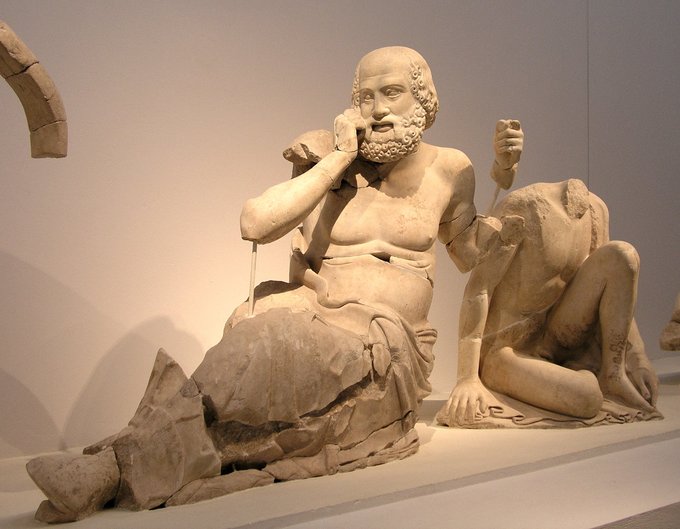
Unlike the static composition of the eastern pediment, the Centauromachy on the western pediment depicts movement that radiates out from its center. The centaurs, fighting men, and abducted women struggle and fight against each other, creating tension in another example of an early portrayal of emotion. Most figures are depicted in the Severe style. However, some, including a centaur, have facial features that reflect their wrath and anger.
The twelve metopes over the pronaos and opisthodomos depict scenes from the twelve labors of Herakles. Like the development in pedimental sculpture, the reliefs on the metopes display the Early Classical understanding of the body. Herakles’ body is strong and idealized, yet it has a level of naturalism and plasticity that increases the liveliness of the reliefs.
The scenes depict varying types of compositions. Some are static with two or three figures standing rigidly, while others, such as Herakles and the Cretan Bull, convey a sense of liveliness through their diagonal composition and overlapping bodies.
Kritios Boy
A slightly smaller-than-life statue known as the Kritios Boy was dedicated to Athena by an athlete and found in the Perserchutt of the Athenian Acropolis. Its title derives from a famous artist to whom the sculpture was once attributed.
The marble statue is a prime example of the Early Classical sculptural style and demonstrates the shift away from the stiff style seen in Archaic kouroi. The torso depicts an understanding of the body and plasticity of the muscles and skin that allows the statue to come to life.
Part of this illusion is created by a stance known as contrapposto. This describes a person with his or her weight shifted onto one leg, which creates a shift in the hips, chest, and shoulders to create a stance that is more dramatic and naturalistic than a stiff, frontal pose. This contrapposto position animates the figure through the relationship of tense and relaxed limbs.
However, the face of the Kritios Boy is expressionless, which contradicts the naturalism seen in his body. This is known as the Severe style. The blank expressions allow the sculpture to appear less naturalistic, which creates a screen between the art and the viewer. This differs from the use of the Archaic smile (now gone), which was added to sculpture to increase their naturalism. However, the now empty eye sockets once held inlaid stone to give the sculpture a lifelike appearance.
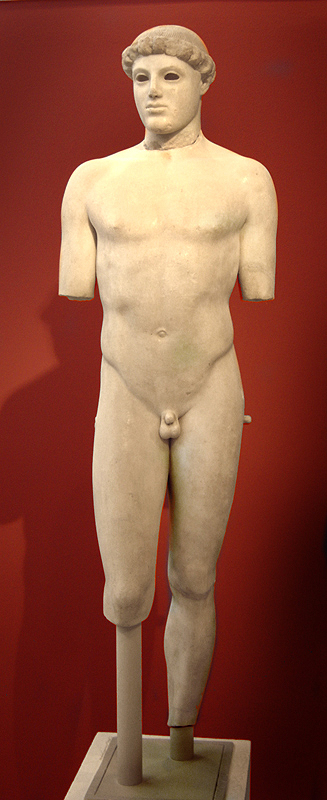
Polykleitos
Polykleitos was a well-known Greek sculptor and art theorist during the early- to mid-fifth century BCE. He is most renowned for his treatise on the male nude, known as the Canon, which describes the ideal, aesthetic body based on mathematical proportions and Classical conventions such as contrapposto.
His Doryphoros, or Spear Bearer, is believed to be his representation of the Canon in sculpted form . The statue depicts a young, well-built soldier holding a spear in his left hand with a shield attached to his left wrist. Both military implements are now lost. The figure has a Severe-style face and a contrapposto stance. In another development away from the stiff and seemingly immobile Archaic style, the Doryphoros’ left heel is raised off the ground , implying an ability to walk.
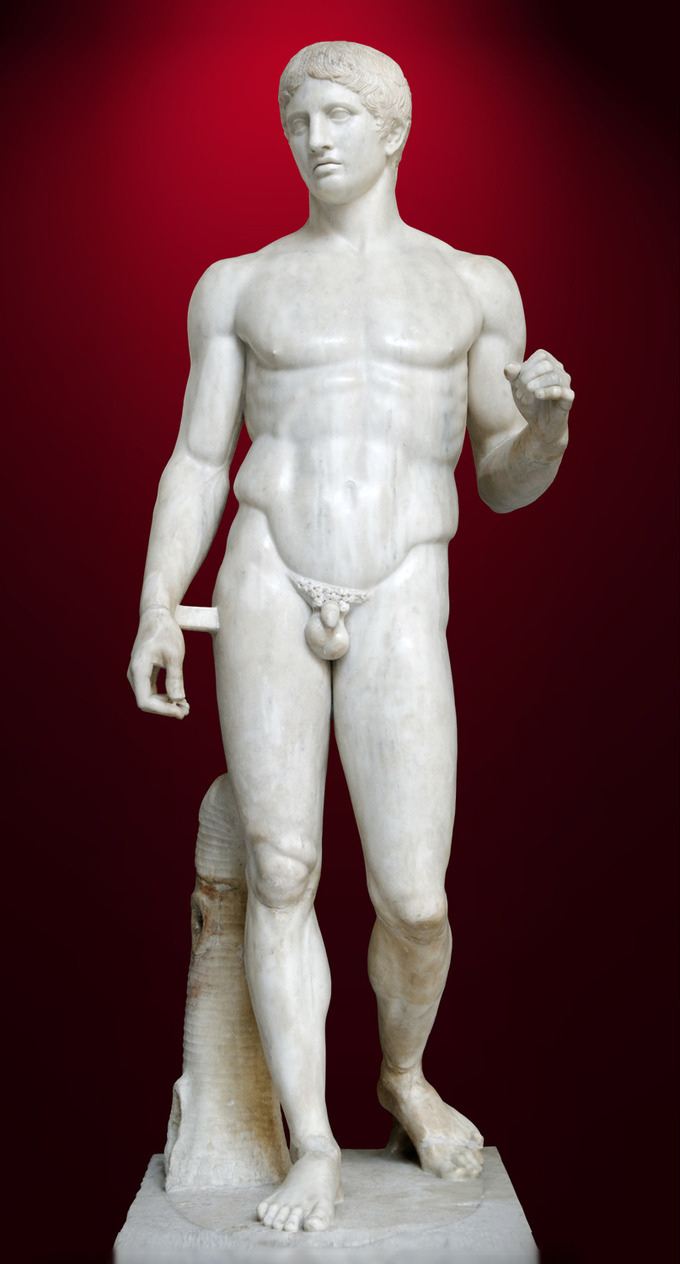
This sculpture demonstrates how the use of contrapposto creates an S-shaped composition. The juxtaposition of a tension leg and tense arm and relaxed leg and relaxed arm, both across the body from each other, creates an S through the body.
The dynamic power of this composition shape places elements—in this case the figure’s limbs—in opposition to each other and emphasizes the tension this creates. The statue, as a visualization of Polykletios’ canon, also depicts the Greek sense of symmetria, the harmony of parts, seen here in the body’s proportions.
Bronze Sculpture in the Greek Early Classical Period
Surviving Greek bronze sculptures from the Early Classical period showcase the skill of Greek artists in representing the body and expressing motion.
Learning Objectives
Discuss characteristics and examples of Greek Bronze sculpture during the Early Classical Period
Key Takeaways
Key Points
- While bronze was a popular material for Greek sculptors, few Greek bronzes exist today. We know a majority of famous sculptors and sculptures only through marble Roman copies and the few bronzes that survived, often from shipwrecks.
- Early Classical bronzes are sculpted in the lost wax method of casting . The figures are created in the Severe style with naturalistic bodies and blank, expressionless faces. The sculptures’ lightweight appearance is due to their hollowness and contributes to their implied potential energy and movement.
- The Charioteer of Delphi, the Riace Warriors, and the Artemision Bronze all display the sculpting characteristics of the Early Classical Severe style while also demonstrating the characteristics of bronze sculpting, including the lightness of the material and liveliness that could be achieved.
Key Terms
- strut: A support rod.
- contrapposto: The position of a figure whose hips and legs are twisted away from the direction of the head and shoulders.
- lost wax: A method of casting in which a model of the sculpture is made from wax. The model is used to make a mold. When the mold has set, the wax is made to melt and is poured away, leaving the mold ready to be used to cast the sculpture.
Greek Bronze Sculpture
Bronze was a popular sculpting material for the Greeks. Composed of a metal alloy of copper and tin, it provides a strong and lightweight material for use in the ancient world, especially in the creation of weapons and art. The Greeks used bronze throughout their history.
Because bronze is a valuable material, throughout history bronze sculptures were melted down to forge weapons and ammunition or to create new sculptures. The Greek bronzes that we have today mainly survived because of shipwrecks, which kept the material from being reused, and the sculptures have since been recovered from the sea and restored.
The Greeks used bronze as a primary means of sculpting, but much of our knowledge of Greek sculpture comes from Roman copies. The Romans were very fond of Greek art, and collecting marble replicas of them was a sign of status, wealth, and intelligence in the Roman world.
Roman copies worked in marble had a few differences from the original bronze. Struts , or supports, were added to help buttress the weight of the marble as well as the hanging limbs that did not need support when the statue was originally made in the lighter and hollow bronze. The struts appeared either as rectangular blocks that connect an arm to the torso or as tree stumps against the leg, which supports the weight of the sculpture, as in this Roman copy of the Diadoumenos Atenas.
Lost Wax Technique
The lost wax technique, which is also known by its French name, cire perdue, is the process that ancient Greeks used to create their bronze statues. The first step of the process involves creating a full-scale clay model of the intended work of art. This would be the core of the model.
Once completed, a mold is made of the clay core and an additional wax mold is also created. The wax mold is then be placed between the clay core and the clay mold, creating a pocket, and the wax is melted out of the mold, after which the gap is filled with bronze. Once cooled, the exterior clay mold and interior clay coreis are carefully removed and the bronze statue is finished.
The multiple pieces are welded together, imperfections smoothed, and any additional elements, such as inlaid eyes and eyelashes, are then added. Because the clay mold must be broken when removing the figure, the lost wax method can be used only for making one-of-a-kind sculptures.
Charioteer of Delphi
The Charioteer of Delphi is an Early Classical bronze sculpture of a life-sized chariot driver. An inscription at the base tells us that the statues were originally dedicated by a man, named Polyzalus of Gela, to Apollo at the Sanctuary of Apollo at Delphi.
Polyzalus commissioned and dedicated the work in commemoration of his victorious chariot race during the Pythian Games. The Charioteer is the only remaining part of a large statue group that included the chariot, grooms, and horses.
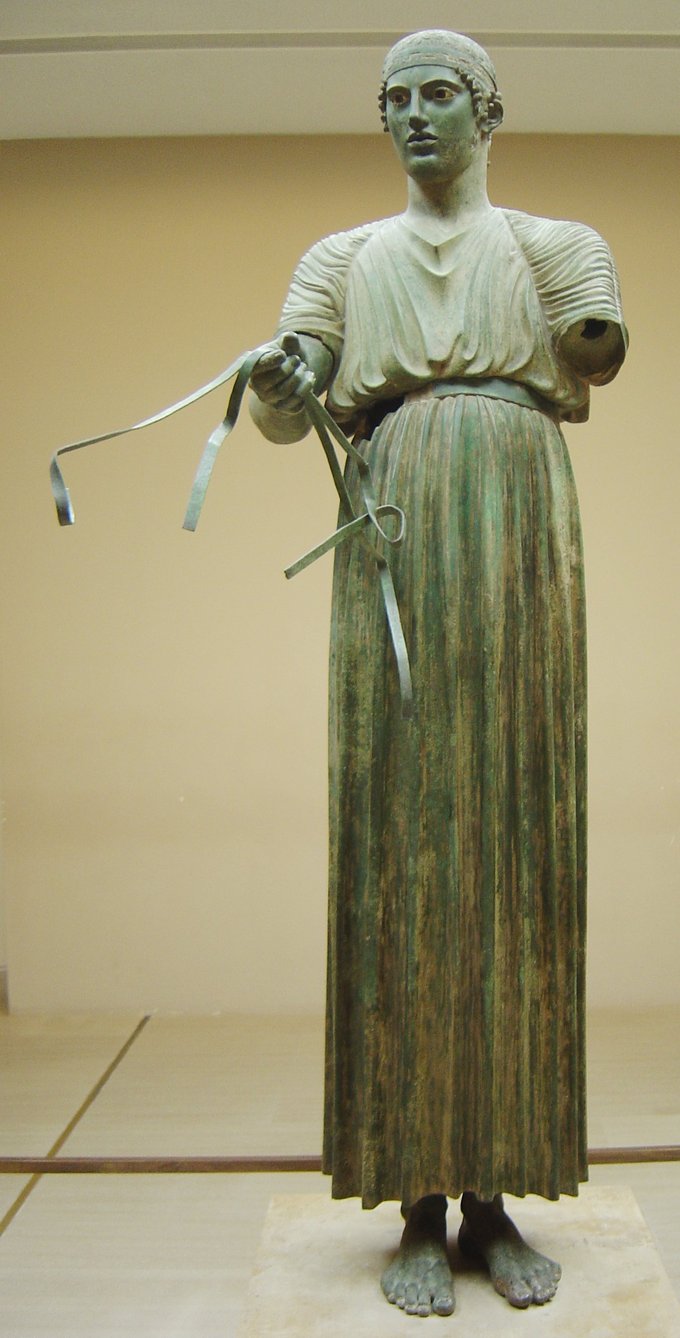
While the commissioner was a tyrant of the Greek colonial city of Gela on Sicily, the statue is believed to have been made in Athens. It was made by the lost wax technique in multiple sections and then assembled.
The Charioteer stands tall, his right arm stretched out to grasp reins; his left arm is missing. He has a high waist, which probably looked more natural when he stood on his chariot. However, despite the high waist, the figure has a high degree of naturalism , on par with the marble sculptural developments of the Early Classical style. The arms, face, and feet are rendered with high plasticity, and the inlaid eyes and added copper of his lips and eyelashes all add a degree of naturalism.
When compared to Archaic sculptures, it appears very natural. However, as an Early Classical sculpture, the Charioteer has yet to achieve the full Classical style. The Archaic smile is gone, but his appears almost blank and expressionless, on par with other sculptures produced in the Severe stye of the Early Classical period.
Riace Warriors
The Riace Warriors are a set of two nude, bronze sculptures of male warriors that were recovered off the coast of Riace, Italy. They are a prime example of Early Classical sculpture and the transition between Archaic to Classical sculpting styles.
The figures are nude, unlike the Charioteer. Their bodies are idealized and appear dynamic, with freed limbs, a contrapposto shift in weight, and turned heads that imply movement. The muscles are modeled with a high degree of plasticity, which the bronze material amplifies through natural reflections of light. Additional elements, such as copper for the lips and nipples, silver teeth, and eyes inlaid with glass and bone, were added to the figures to increase their naturalism. Both figures originally held a shield and spear, which are now lost. Warrior B wears a helmet, and it appears that Warrior A once wore a wreath around his head.

Artemision Bronze
The Artemision Bronze represents either Zeus or Poseidon. Both gods were represented with full beards to signify maturity. However, it is impossible to identify the sculpture as one god or the other because it can either be a lightning bolt (symbolic of Zeus) or a trident (symbolic of Poseidon) in his raised right hand.
The figure stands in heroic nude, as would be expected with a god, with his arms outstretched, preparing to strike. The bronze is in the Severe style with an idealized, muscular body and an expressionless face.
Like the Charioteer and the Riace Warriors, the Artemision Bronze once held inlaid glass or stone in its now-vacant eye sockets to heighten its lifelikeness. The right heel of the figure rises off the ground , which anticipates the motion the figure is about to undertake.
The full potential of the god’s motion and energy, as well as the grace of the body, is reflected in the modeling of the bronze.
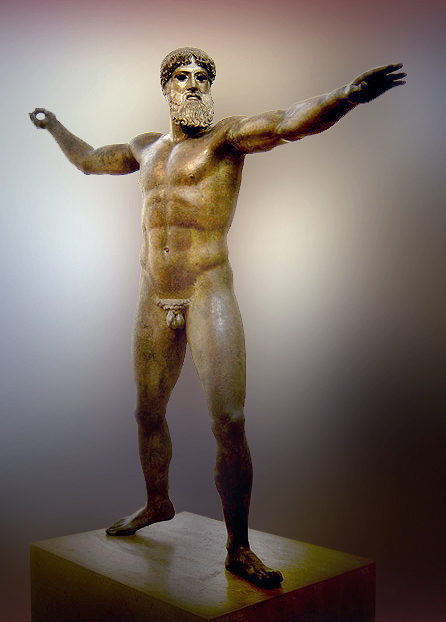
Ceramics in the Greek Early Classical Period
The ceramic art from Early Classical Greece displays important compositional developments and increased naturalism in the figures.
Learning Objectives
Examine the developments in ceramic art during the Early Classical period, including naturalism and white-ground painting
Key Takeaways
Key Points
- Red-figure painting continued during the Early Classical period. The changes in the depiction of the body and in the drapery of the figures began to change, reflecting the stylistic changes and increased naturalism seen in Classical sculpture .
- The style of red-figure painting also diversified as painters began to depict figures on multiple ground lines , show characters from a variety of perspectives (including three-quarter view), and utilize more naturalism (as seen by the work of the Niobid Painter).
- White-ground painting, developed in 500 BCE, became popular during the Classical period. White-ground pottery was coated in a white slip before being fired and painted, allowing for the use of polychromy .
- Early white-ground painting (Type I) resembled black-figure painting until it was supplanted by the more familiar outline paintings. White-ground painting became the primary style for lekythoi, vessels used to hold oils that had a funerary context. Due to this context, many of the scenes painted on lekythoi depicted scenes of funerary rites and rituals , or scenes that alluded to impending death.
Key Terms
- lekythos: A type of ancient Greek pottery used for storing oil and previous liquids. The body is narrow and has a single handle attached to the neck of the vessel. They typically stood 10 to 20 inches tall, but when used as grave markers could be much larger.
- polychromy: The art or practice of combining different colors, especially brilliant ones, in an artistic way.
- white-ground: A style of ancient Greek vase painting in which figures appear on a white background.
Classical Period Ceramics
The Classical period witnessed the continuation of red- and black-figure painting techniques on ceramic objects. While artists continued to produce black-figure paintings into the second century BCE, the technique became increasingly rare, overtaken around 520 BCE by red-figure painting.
Attic red-figure vases were exported throughout Greece and beyond, and for a long time dominated the market for fine ceramics. Only a few centers of pottery production could compete with Athens in terms of its innovation, quality, and production capacity.
Red-Figure Painting
Red-figure painting continued to flourish during the Early, High, and Late Classical periods. The naturalism of the figures in Early Classical vase painting continued to increase, as the figures became less stocky and less linear. Both the figures and their drapery began to appear more plastic, and the scenes often depicted a single moment within a mythical story or event. Furthermore, vase painting began to be influenced by the changes occurring in both sculpture and the large-scale painting of walls and panels.
The Mannerists
The Mannerists were a group of Attic red-figure painters known for their affected (emotive) subject matter. They were active from about 480 BCE until near the end of the fifth century BCE. Their main characteristic is that they maintained features of black-figure vase painting in the red-figure technique.
Their figures seem elongated and have small heads, the garment folds fall stiff and resemble stairs, and the images are framed with black-figure style ornamentations. The range of motifs is also influenced by previous periods. The figures gesticulate as if using a form of sign language—the hands often appear stiff and theatrical. We can see typical Mannerist small heads and affected gestures in the Pan Painter’s Herakles Fighting Busiris (c. 470 BCE).
The Niobid Painter’s red-figure krater of Artemis and Apollo slaying the children of Niobe, from 460 BCE, is believed to be a composition inspired by a panel painting. The side of the vessel depicting Artemis and Apollo relates to the myth of the twin god and goddess who slew Niobe’s fourteen children after she boasted that her ability to birth children exceeded Leto, the mother of Apollo and Artemis.
This story alludes to ancient Greek admonitions against hubris, or extreme pride. The scene is one of the first vase painting scenes to show the figures on different ground lines. Apollo and Artemis stand in the center of the vessel as Niobe’s children fall to ground around them. One child has even fallen behind a rock in the landscape.
On the other side of the vase is an image of gods and heroes, with Herakles at the center. All the figures stand and sit on various ground lines. The figures on both sides are depicted from multiple angles, including three-quarter view, and a profile eye is used for the figures in profile, a first in Greek vase painting.

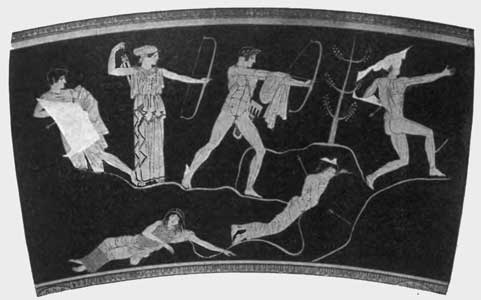
The Berlin Painter is another well-known Early Classical vase painter. His unique style depicts figures, isolated from context, on a small ground line against a glossy black background. His figures also start in the middle of the vase and extend onto the vessel’s shoulder, stopping at the neck.
He pays particular attention to the details of the body and the drapery of each figure, and allows both figure and drapery to express emotion, space , and movement. His painting entitled Ganymede with a Hoop and Cock conveys a sense of dynamism by arranging the body through a series of diagonal outlines, using contour lines to mark the locations of muscles and tendons beneath the skin.

White-Ground Painting
White-ground painting developed around 500 BCE and gained popularity during the following century. The technique is based on the use of paints, instead of slip, to create polychrome vessels.
The vessels were first coated in a white slip before various colors of paint were added. The white background and firing techniques allowed for various colors to be used, including blue, yellow, red, brown, and green. Because the style is less durable than black- and red-figure painting, it was often used for votives and as grave offerings .
The common outline paintings of the white-ground technique would not dominate the style until approximately the mid-fifth century BCE. For the first 50 years of white-ground painting, known as Type I, the imagery resembled conventional black-figure painting, with the color of the background as the only difference. This depiction of Herakles fighting Geryon provides an example of Type I white-ground painting.
White-ground painting is often seen on a lekythos , a vessel used to hold oils, which were sometimes used for anointing the dead. Due to this funerary function, lekythoi were also used as grave offerings. As such, many of the scenes painted on white-ground lekythoi depict or allude to funerary scenes (such as funerary rites and rituals) or images of warriors departing their wives for battle and death. While the scene of Herakles fighting Geryon depicts a rather violent prelude to death, the imagery on later lekythoi is somewhat more sedate.
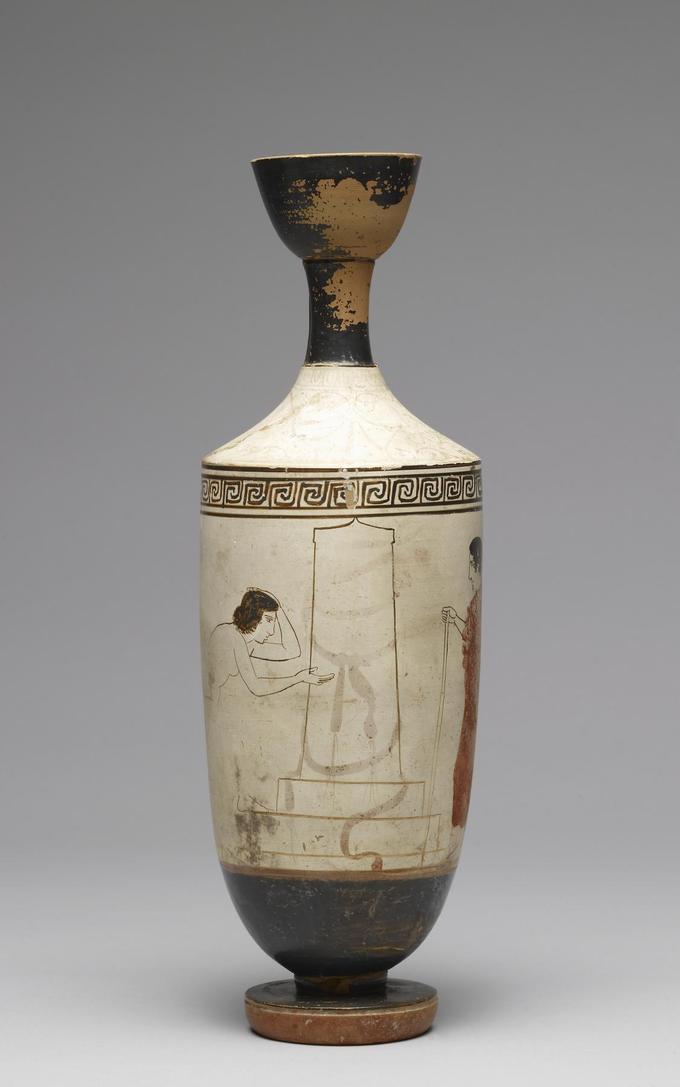
The Achilles Painter, a pupil of the Berlin Painter and creator of both red-figure and white-ground vessels, is one of the most well-known white ground painters. The scenes he painted on his white-ground lekythoi are filled with pathos and sorrow, often depicting women sitting in front of grave stelae or bidding their battle-bound husbands farewell.
Overall, in both white-ground and red-figure painting during the Early Classical period, the form of the body was perfected by the artisans. Painted vessels were now depicting figures on a two-dimensional plane, with the illusion of three-dimensional space. These figures were rendered in that space naturally, in terms of their movement and form.
Black-figure painting nearly disappeared in the Early Classical period and was primarily reserved for objects made to seem old or to recall antique styles, such as victory amphorae for the Panhellenic Games.
- Curation and Revision. Provided by: Boundless.com. License: CC BY-SA: Attribution-ShareAlike
- GR 08-04-23 Olympia Museum Zeustempel Ostgiebel2. Provided by: Wikimedia. Located at: commons.wikimedia.org/wiki/File:GR_08-04-23_Olympia_Museum_Zeustempel_Ostgiebel2.JPG. License: CC BY-SA: Attribution-ShareAlike
- 623px-Centaure_i_lu00e0pita,_frontu00f3_occidental_del_temple_de_Zeus_d'Olu00edmpia,_(Museu_Arqueolu00f2gic_d'Olu00edmpia).jpeg. Provided by: Wikimedia Commons. Located at: commons.wikimedia.org/w/index.php?curid=19863856. License: CC BY-SA: Attribution-ShareAlike
- 455px-Mu00e8topa_del_temple_de_Zeus_d'Olu00edmpia_amb_representaciu00f3_del_bou_de_Creta_(Museu_Arqueolu00f2gic_d'Olu00edmpia).jpeg. Provided by: Wikimedia Commons. Located at: commons.wikimedia.org/w/index.php?curid=19852244%20. License: CC BY-SA: Attribution-ShareAlike
- 009MA Kritios. Provided by: Wikimedia. Located at: commons.wikimedia.org/wiki/File:009MA_Kritios.jpg. License: CC BY-SA: Attribution-ShareAlike
- 640px-Olympia-ZeusTempelRestoration.jpg. Provided by: Wikimedia Commons. Located at: commons.wikimedia.org/w/index.php?curid=866537. License: Public Domain: No Known Copyright
- 436px-Metopa-templo-zeus2_crop.jpg. Provided by: Wikimedia Commons. Located at: commons.wikimedia.org/w/index.php?curid=15582867%20. License: Public Domain: No Known Copyright
- Doryphoros MAN Napoli Inv6011-2. Provided by: Wikipedia. Located at: en.Wikipedia.org/wiki/File:Doryphoros_MAN_Napoli_Inv6011-2.jpg. License: CC BY-SA: Attribution-ShareAlike
- Hexastyle. Provided by: Wikipedia. Located at: en.Wikipedia.org/wiki/Portico#Hexastyle. License: CC BY-SA: Attribution-ShareAlike
- Kritios Boy. Provided by: Wikipedia. Located at: en.Wikipedia.org/wiki/Kritios_Boy. License: CC BY-SA: Attribution-ShareAlike
- Polykleitos. Provided by: Wikipedia. Located at: en.Wikipedia.org/wiki/Polykleitos. License: CC BY-SA: Attribution-ShareAlike
- Contrapposto. Provided by: Wikipedia. Located at: en.Wikipedia.org/wiki/Contrapposto. License: CC BY-SA: Attribution-ShareAlike
- Temple of Zeus, Olympia. Provided by: Wikipedia. Located at: en.Wikipedia.org/wiki/Temple_of_Zeus,_Olympia. License: CC BY-SA: Attribution-ShareAlike
- Doryphoros. Provided by: Wikipedia. Located at: en.Wikipedia.org/wiki/Doryphoros. License: CC BY-SA: Attribution-ShareAlike
- Severe Style. Provided by: Wikipedia. Located at: en.Wikipedia.org/wiki/Severe%20style. License: CC BY-SA: Attribution-ShareAlike
- Perserchutt. Provided by: Wikipedia. Located at: en.Wikipedia.org/wiki/Perserchutt. License: CC BY-SA: Attribution-ShareAlike
- 359px-Diadoumenos-Atenas.jpg. Provided by: Wikimedia Commons. Located at: commons.wikimedia.org/w/index.php?curid=2892511. License: CC BY-SA: Attribution-ShareAlike
- Reggio calabria museo nazionale bronzi di riace. Provided by: Wikimedia. Located at: commons.wikimedia.org/wiki/File:Reggio_calabria_museo_nazionale_bronzi_di_riace.jpg. License: CC BY-SA: Attribution-ShareAlike
- Netuno16b. Provided by: Wikipedia. Located at: en.Wikipedia.org/wiki/File:Netuno16b.jpg. License: CC BY-SA: Attribution-ShareAlike
- Delphi charioteer front DSC06255. Provided by: Wikimedia. Located at: commons.wikimedia.org/wiki/File:Delphi_charioteer_front_DSC06255.JPG. License: CC BY-SA: Attribution-ShareAlike
- Bronze Sculpture. Provided by: Wikipedia. Located at: en.Wikipedia.org/wiki/Bronze_sculpture. License: CC BY-SA: Attribution-ShareAlike
- Ancient Greek Sculpture. Provided by: Wikipedia. Located at: en.Wikipedia.org/wiki/Ancient_Greek_sculpture. License: CC BY-SA: Attribution-ShareAlike
- Riace Bronzes. Provided by: Wikipedia. Located at: en.Wikipedia.org/wiki/Riace_bronzes. License: CC BY-SA: Attribution-ShareAlike
- Charioteer of Delphi. Provided by: Wikipedia. Located at: en.Wikipedia.org/wiki/Charioteer_of_Delphi. License: CC BY-SA: Attribution-ShareAlike
- Artemision Bronze. Provided by: Wikipedia. Located at: en.Wikipedia.org/wiki/Artemision_Bronze. License: CC BY-SA: Attribution-ShareAlike
- Lost Wax Method. Provided by: Wikipedia. Located at: en.Wikipedia.org/wiki/Lost_wax_method. License: CC BY-SA: Attribution-ShareAlike
- Strut. Provided by: Wiktionary. Located at: en.wiktionary.org/wiki/strut. License: CC BY-SA: Attribution-ShareAlike
- Contrapposto. Provided by: Wiktionary. Located at: en.wiktionary.org/wiki/contrapposto. License: CC BY-SA: Attribution-ShareAlike
- Pittore dei niobidi, calice del louvre, 460 a.c.. Provided by: Wikimedia. Located at: commons.wikimedia.org/wiki/File:Pittore_dei_niobidi,_calice_del_louvre,_460_a.c..jpg. License: CC BY-SA: Attribution-ShareAlike
- 600px-Herakles_Geryon_MAR_Palermo.jpg. Provided by: Wikimedia Commons. Located at: commons.wikimedia.org/w/index.php?curid=4724536. License: CC BY: Attribution
- Mousai_Helikon_Staatliche_Antikensammlungen_Schoen80_full 2.jpg. Provided by: Wikimedia. Located at: commons.wikimedia.org/wiki/File:Mousai_Helikon_Staatliche_Antikensammlungen_Schoen80_full.jpg. License: CC BY-SA: Attribution-ShareAlike
- Thanatos Painter - White-Ground Lekythos - Walters 482012. Provided by: Wikimedia. Located at: commons.wikimedia.org/wiki/File:Thanatos_Painter_-_White-Ground_Lekythos_-_Walters_482012.jpg. License: CC BY-SA: Attribution-ShareAlike
- Berlin Painter Ganymedes Louvre G175. Provided by: Wikimedia. Located at: commons.wikimedia.org/wiki/File:Berlin_Painter_Ganymedes_Louvre_G175.jpg. License: CC BY-SA: Attribution-ShareAlike
- 347px-NAMA_Hu00e9raclu00e8s_&_Busiris.jpg. Provided by: Wikimedia Commons. Located at: commons.wikimedia.org/w/index.php?curid=473287. License: Public Domain: No Known Copyright
- Krater Niobid Painter A Louvre G341. Provided by: Wikimedia. Located at: commons.wikimedia.org/wiki/File:Krater_Niobid_Painter_A_Louvre_G341.jpg. License: CC BY-SA: Attribution-ShareAlike
- Mannerists (Greek Vase Painting). Provided by: Wikipedia. Located at: en.Wikipedia.org/wiki/Mannerists_(Greek_vase_painting). License: CC BY-SA: Attribution-ShareAlike
- White-Ground Technique. Provided by: Wikipedia. Located at: en.Wikipedia.org/wiki/White_ground_technique. License: CC BY-SA: Attribution-ShareAlike
- Pottery of Ancient Greece. Provided by: Wikipedia. Located at: en.Wikipedia.org/wiki/Pottery_of_ancient_Greece%23White_ground_technique. License: CC BY-SA: Attribution-ShareAlike
- Achilles Painter. Provided by: Wikipedia. Located at: en.Wikipedia.org/wiki/Achilles_Painter. License: CC BY-SA: Attribution-ShareAlike
- Lekythos. Provided by: Wikipedia. Located at: en.Wikipedia.org/wiki/Lekythos. License: CC BY-SA: Attribution-ShareAlike
- Red-Figure Painting. Provided by: Wikipedia. Located at: en.Wikipedia.org/wiki/Red-figure_painting%23Early_and_High_Classical. License: CC BY-SA: Attribution-ShareAlike
- Niobe. Provided by: Wikipedia. Located at: en.Wikipedia.org/wiki/Niobe%23Examples_in_painting_and_sculpture. License: CC BY-SA: Attribution-ShareAlike
- Niobid Painter. Provided by: Wikipedia. Located at: en.Wikipedia.org/wiki/Niobid_Painter. License: CC BY-SA: Attribution-ShareAlike
- Berlin Painter. Provided by: Wikipedia. Located at: en.Wikipedia.org/wiki/Berlin_Painter. License: CC BY-SA: Attribution-ShareAlike
- Polychromy. Provided by: Wiktionary. Located at: en.wiktionary.org/wiki/polychromy. License: CC BY-SA: Attribution-ShareAlike
- Definition of Lekythos in Art History. Provided by: Boundless Learning. Located at: www.boundless.com/art-history/definition/lekythos. License: CC BY: Attribution
- White-Ground. Provided by: Wikipedia. Located at: en.Wikipedia.org/wiki/White-ground. License: CC BY-SA: Attribution-ShareAlike

